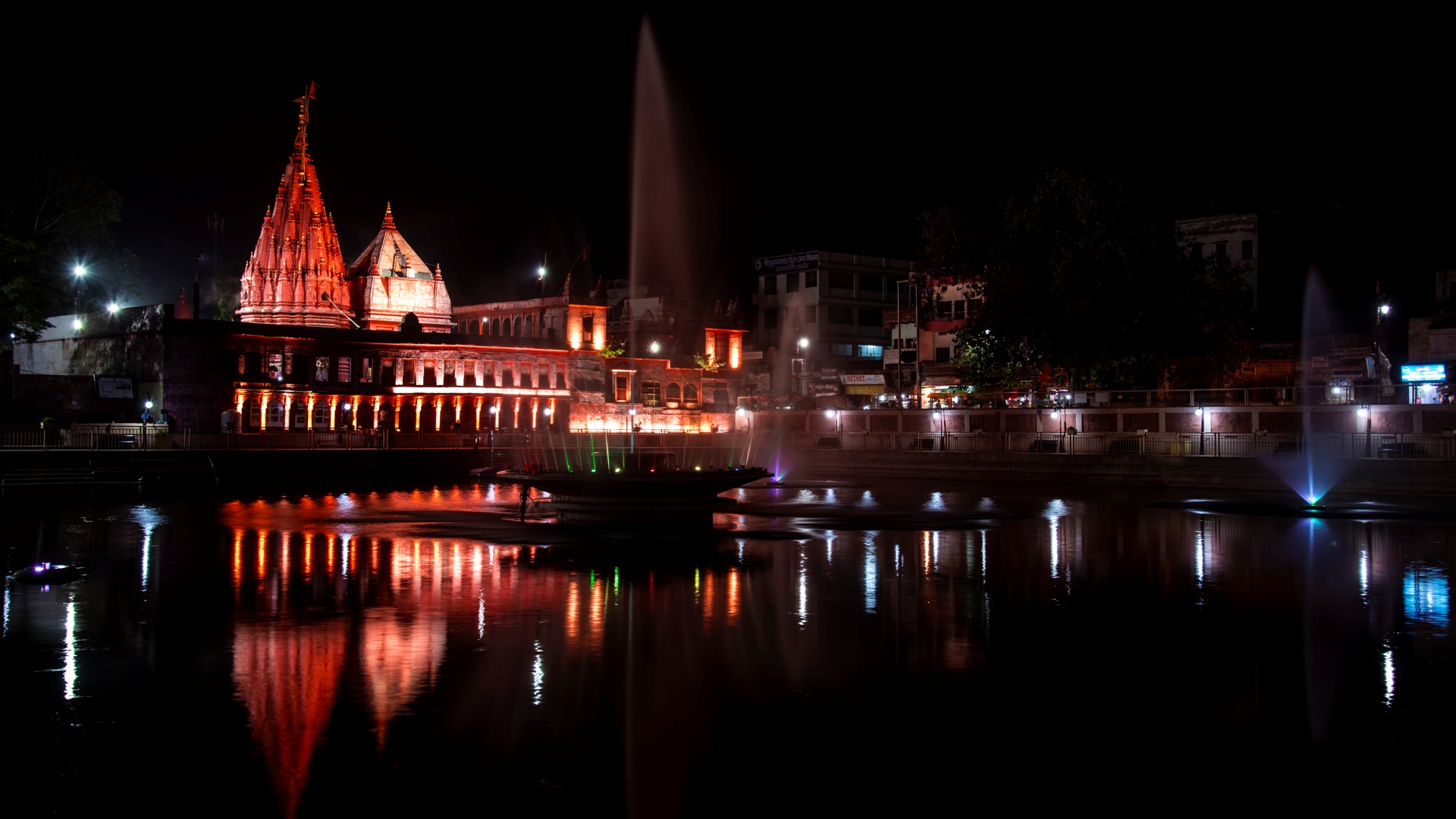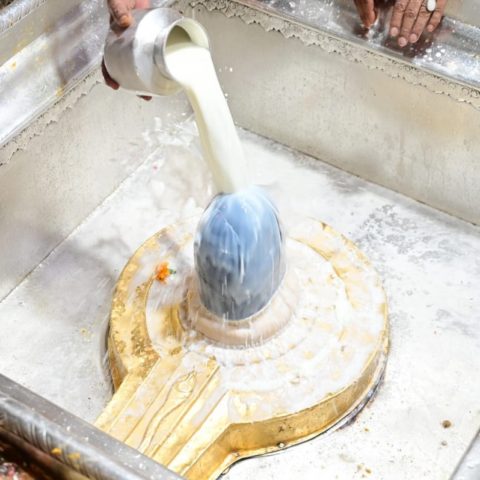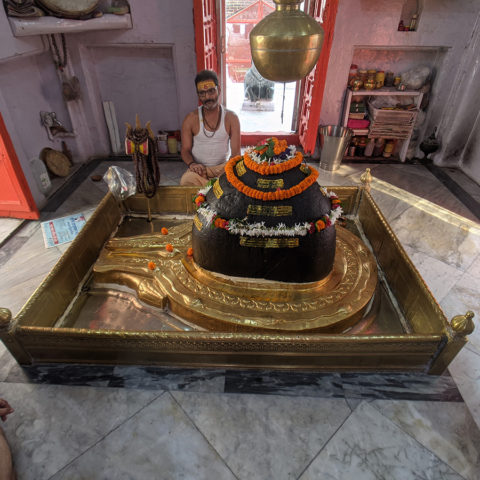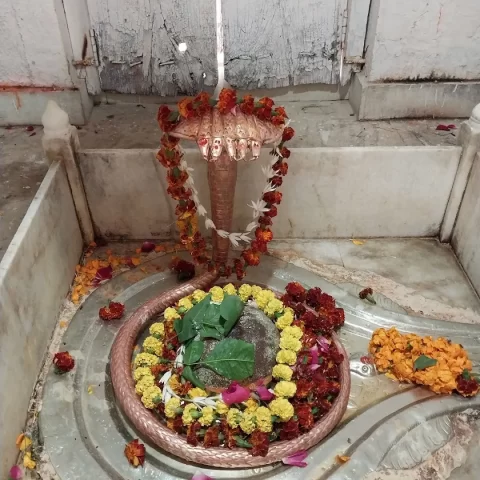
Durgakund Temple, a famous temple dedicated to Durga Devi is located in the Bhelupur region of Kashi. The temple is also known as the Durga Kund. The current temple structure was constructed in the 18th century by Rani Bhabani of Natore (currently in Bangladesh). A sacred pond called as Durga Kund is located on the right side of the temple. This pond was historically connected to the Ganga River.
The temple which is built entirely of stone appears red. The red colour represents the colour of victory & strength. The Nagara style of architecture has been used in the entire construction with a multi-tiered Shikhara, which appears as a Sahasrara (thousand-petalled lotus). Many intricate carvings further beautify the entire temple structure.
How did the Durgakund temple get established in Kashi?
The pastime of the establishment of the Durgakund Temple in Kashi is spoken by Sage Vyasadeva in the Devi Bhagavatam.
Subahu, the King of Kashi wanted to conduct the swayamvara ceremony of his beautiful daughter Shashikala. The young princess had heard about a very charming and noble prince called Sudarshana, the son of King Dhruvasandi, the ruler of Koshala in passing. She desired to marry Sudarshana, who was living in exile in the forest at Bharadwaja Muni’s ashram along with his mother Manorama.
Sudarshana and his mother had taken shelter in the ashram after the death of King Dhruvasandhi. Queen Manorama had to flee Koshala with Sudarshana after her father King Virasena, the ruler of Magadha was killed by King Yudhajit, the ruler of Ujjain. Lilavathi was King Dhruvasandhi’s second wife. Being Lilavathi’s father, Yudhajit killed Virasena to install Lilavathi’s son Shatrujit on the throne of Koshala even though Sudarshana was the most qualified to become the King.
Bhagavathi Devi appeared in Shashikala’s dream one night and told her that Sudarshana was capable of fulfilling any desire of the princess. Shashikala woke up the next morning in an extremely joyful state. She did not reveal the reason for her extreme happiness even to her mother.
Once, a Brahmana came to meet the princess when she was sitting beneath a Champaka tree in the palace garden collecting flowers. The Brahmana informed the princess that the best of all men ‘Sudarshana’ was staying in the ashram of Bharadwaja Muni. And that there was no other man fit to be Shashikala’s husband. She was very much ecstatic on hearing the brahmana’s words.
Her attachment to Sudarshana increased. She would tell her girlfriends about her love for Sudarshana and her desire to marry him.
Sudarshana started meditating on Bhagavathi with the bija mantra he was initiated into by the Sages of the ashram. He had a vision of Bhagavathi through intense meditation on the Goddess. At that time, the King of the Nishadas and the chief of Shringaverapura arrived at the ashram. He gifted Sudarshana a nice chariot drawn by four horses and decorated with flags befitting the future King of Koshala. The King of Nishadas was sent away after receiving him as an honoured guest.
The Sages at the ashram foresaw the future of Sudarshana and blessed him. They assured Queen Manorama that her son would soon become the King of Koshala.
Swayamvara of Shashikala
In the meantime, King Subahu arranged for the swayamvara ceremony after getting to know that his daughter Shashikala desired the same. He made grand and elaborate arrangements to conduct the ceremony inviting many heroic kings to participate.
Seeing all this, the big-eyed princess told her girlfriend in sorrow “Better go to my mother and tell her privately that I have already mentally selected my husband as the beautiful Sudarshana, the son of King Dhruvasandhi in my mind; I won’t marry any other prince than him; the Goddess Bhagavathi has settled him for my husband.”
Shashikala’s girlfriend conveyed the message to her mother Queen Vaidarbhbi, who in turn conveyed it to King Subahu. Laughing intermittently, the King told his wife that it wasn’t possible as Sudarshana was exiled and poor. Shashikala could select any honourable king as her husband at the swayamvara.
Seating Shashikala on her lap, Queen Vaidarbhi consoled her daughter with sweet words conveying her father’s displeasure. But Shashikala responded by saying that she wouldn’t accept any other man apart from Sudarshana as her husband. She informed Queen Vaidarbhi that Bhagavathi had ordained Sudarshana as her husband. The Queen reported Shashikala’s stand to the King.
A day before the swayamvara ceremony, the princess sent a trustworthy brahmana to meet Sudarshana at the ashram of Bharadwaja Muni. The brahmana delivered the message of the princess and came back. Sudarshana decided to start for the city of Kashi immediately with the blessings of Bharadwaja Muni. Queen Manorama decided to accompany her son.
Mounting his special chariot, Sudarshana reached Kashi. King Subahu received Sudarshana well and made arrangements for his stay apart from giving him various presents.
Many kings such as the kings of Madra, Karnat, Kerala, Mahishmati, Panchala, etc came for the swayamvara ceremony including King Yudhajit and his daughter’s son Shatrujit. Certain Kings had come simply to witness the ceremony. The Kings were discussing Sudarshana’s presence in Kashi. King Yudhajit addressed them saying that he would kill Sudarshana for the sake of Shatrujit.
Hearing the words of King Yudhajit, the King of Kerala spoke out loudly that it was against dharma to kill Sudarshana in this peaceful ceremony. He further said that truth and dharma always win. Hence, the princess should be allowed to select the bridegroom of her choice without any quarrel. King Yudhajit responded by talking about the Kshatriya spirit and its glories.
After King Subahu stepped in, he was asked to reveal whom he would hand over his daughter to. He said that his daughter has fixed Sudarshana as her husband and that she would not move an inch from her decision. The chief Kings called upon Sudarshana and inquired his intent in coming to Kashi.
Being a staunch devotee of Bhagavathi, he informed them that he has come to witness the swayamvara ceremony on the orders of Bhagavathi. The Kings informed him that Yudhajit was planning to kill him. Extolling the glories of Bhagavathi, he said that he sees no one as enemy. Thus, being pleased by Sudarshana’s words, everyone retired for the day.
On the day of the swayamvara, King Subahu went to get his daughter after the kings were seated. Shashikala told him that she wouldn’t go before lustful Kings nor would she walk around like a prostitute. Rather, she asked King Subahu to get her married to Sudarshana at an auspicious moment. Shashikala spoke with great reason and understanding.
King Subahu understood the reasoning of his daughter. But he was anxious that the kings assembled for the swayamvara ceremony wouldn’t tolerate such words.
In utter humility, King Subahu went before the kings assembled in the hall and told them in humility that his daughter wouldn’t attend the ceremony. He also told them that Shashikala may commit suicide, if forced so. He pleaded with the assembled kings in the best of words and offered them compensation in the form of jewels, clothes, etc.
The kings did not utter a word on hearing the pleas of King Subahu. The only exception was King Yudhajit who was seething with anger. He threatened King Subahu not to marry off Shashikala to Sudarshana. Instead, she could choose anyone else. Yudhajit threatened to kill King Subahu, Sudarshana and carry Shashikala away by force.
With a heavy heart, King Subahu went and spoke about the conversation with his Queen. She in turn went and spoke the same to Shashikala, who remained firm on her desire. Even the King spoke to his daughter. Shashikala, who was firm in her devotion to Bhagavathi vowed to marry Sudarshana only. She advised her father to get her married to Sudarshana on the faith and devotion to Bhagavathi’s instructions. She would even leave the kingdom with Sudarshana to prevent a bad outcome.
Feeling strengthened by the powerful words of his daughter, King Subahu decided to conduct Shashikala’s marriage ceremony with Sudarshana. He went and intelligently asked the assembled kings to go back to their allotted quarters. He further informed that the swayamvara ceremony would be conducted the next day after persuasively bringing his daughter Shashikala to the hall. The kings believed his words and went away.
King Subahu started making arrangements to conduct the marriage ceremony of his daughter and Sudarshana at night. He kept his daughter in a well-guarded chamber. Then, Sudarshana was bathed and worshiped on a vedi (platform). The King presented Sudarshana with various gifts befitting his position.
The noble Sudarshana, happily and respectfully accepted all the gifts. Seeing this, his mother Queen Manorama became free from all anxieties regarding her son’s future.
Sudarshana was carried to the vivaha mantapa by the King’s ministers in a carriage. The bride was brought to the vivaha mantapa by the elderly women after dressing and adorning her. The sacred fire was lit and the marriage ceremony was performed without any obstacles. After the ceremonies, the King gifted Sudarshana many more things like chariots, horses, servants, elephants, etc.
He also asked Queen Manorama to remain in Kashi ruling over the kingdom with Subahu as her commander. She was also offered half of the kingdom. Being pleased with the humility and magnanimity of King Subahu, Queen Manorama simply praised the King and thanked him for his generosity.
The next morning, the kings who had come for the swayamvara ceremony understood that the princess had been married off to Sudarshana. They were enraged at this act and vowed to prevent Sudarshana from going away with the bride. The King was in anxiety that the assembled kings might harm his daughter and her husband. He started making arrangements for the departure of the newly-wed bride and bridegroom.
After hosting his son-in-law for six days at his palace, the King presented the couple with many other gifts including jewels and ornaments. Sudarshana asked permission to leave the palace with his wife. The King was informed that the other kings were blocking Sudarshana’s path at various places. But Sudarshana assured the King that he needn’t fear any harm from them as Bhagavathi would protect them.
Assured by Sudarshana’s words, the King gave permission to depart. Sudarshana departed with his wife Shashikala followed by King Subahu and his army. King Subahu grew anxious seeing the armies of the other kings but Sudarshana had immense faith in Bhagavathi’s protection. He started meditating on the kama bija mantra of Goddess Bhagavathi and hence, remained out of danger. He asked King Subahu not to kill the other kings or their soldiers.
In the meantime, the kings prepared to take away Shashikala and hence, started fighting. Few kings simply witnessed the fight. King Yudhajit appeared on the scene to help his grandson Shatrujit kill Sudarshana and take away the bride. King Subahu’s army stepped in to protect the bride and bridegroom.
Devi Durga appears to help Sudarshana
Suddenly, Goddess Bhagavathi appeared at the spot seated on a lion. Durga Devi was divinely beautiful adorned with various ornaments and weapons. The excellent Mandara garland she wore added to her lustre. The kings couldn’t figure out who she was and hence, asked one another.
Sudarshana pointed out that the Goddess had come to protect them. They bowed down to Bhagavathi with great devotion. Then the lion, the vehicle of the Goddess, roared, making tremendous noise. Hearing the roaring of the lion, all the elephants trembled. At that time, the winds began to blow violently and the four quarters assumed an awful appearance.
Sudarshana asked the general to march through the route where the Kings and their armies were staying fearlessly, now that Bhagavthi has come to protect them. King Yudhajit was enraged and so, started shooting arrows at Sudarshana but they were all well-countered by Sudarshana.
When the fighting became intense, Bhagavathi herself started firing arrows at Yudhajit and his grandson. Assuming various forms, she fought for her devotee Sudarshana and thus killed King Yudhajit and his grandson Shatrujit. Even King Subahu’s uncle and cousin who sided with King Yudhajit were killed. All the kings were surprised at the turn of events.
King Subahu was very happy that King Yudhajit was dead. Being free from the anxiety about the safety of his daughter and son-in-law, he praised Goddess Bhagavthi eloquently. He chose the finest of words to praise Bhagavthi and her qualities. Being pleased with the offerings of King Subahu, the universal mother asked him to choose a boon for himself.
The King glorified Goddess Bhagavathi and prayed that she stays in Kashi forever and protect it along with its citizens. He also desired that Goddess Bhagavathi be celebrated as Durga Devi thereafter in the city. The Goddess blessed the prayers of the King.
Sudarshana too came and extolled Goddess Durga Devi in the finest of words. He asked the Goddess to give him orders on his next course of duty. Hearing the petition, Durga Devi said the following with great affection for her devotee:
“O good soul! Go to Ayodhya and govern the country befitting your family. O king! Constantly remember Me and worship Me with great care. I will always look after the welfare of your kingdom. Especially in the eighth, fourteenth, and in the ninth day of the lunar half month, worship Me according to the prescribed rites and rules and offer me sacrifices. O sinless one! Establish my Deity in this city and worship it three times, morning, mid-day and evening carefully and with devotion.
It is noteworthy that My great worship in autumn for the nine nights (Navaratri) ought to be done with the greatest devotion. O king! In the month of Chaitra, Magh, Ashwin, and Ashada, My grand festival should be done on the four Navaratris respectively; and especially on the fourteenth and on the eighth day of the black half, all persons ought to worship Me with their minds full of devotion towards Me.”
Blessing Sudarshana, Goddess Durga Devi disappeared. Sudarshana prepared to execute the orders of Durga Devi. All the Kings including King Subahu bowed before Sudarshana asking him for their protection. They wanted to know more about Durga Devi who came to protect Sudarshana. He explained the glories of Durga Devi to the Kings and then, set out for Ayodhya parting ways with his father-in-law.
After reaching Ayodhya with Shashikala, Sudarshana was anointed as the King of Koshala. He ordered the construction of a grand palace to worship Durga Devi. After the construction of the palace, Durga Devi was consecrated in the palace. Meanwhile, King Subahu too consecrated the Deity of Durga Devi in Kashi at Durgakund Temple and started worshipping her.
Festivals at Durgakund Temple, Kashi
Navratri is the main festival celebrated at the Durgakund temple. It comes twice in a year in the month of Chaitra (March) and Ashwin (October). Not to forget the Nag-Panchami festival in July/August. Lord Vishnu is depicted lying on his Ananta Shesha bed in the Durgakund Kalyani on this occasion.
Temple timings of Durgakund Temple, Kashi
The divinely beautiful and enchanting Deity of Durga Devi at the temple holds a Trishul (Trident) in one hand and a Chakra (Discus) in the other. She appears like a bust adorned with sparkling jewellery. Other smaller shrines can be seen in the compound. You can have the darshan of Durga Devi at the following times:
Morning: 05.00 AM to 12.00 PM
Evening: 04.00 PM to 09.00 PM
How to reach Durgakund Temple
The Durgakund temple is located two kilometres from BHU (Banaras Hindu University) at Bhelupur in Kashi. Hence, reach Kashi first! After getting your permission to reside in Kashi for the pilgrimage duration, do have the darshan of the splendid Goddess at her abode. She can remove any of your troubles! If you’re looking for the best experience, the Kashi Yatra or Ayodhya-Kashi Yatra of Tirtha Yatra deserves a mention.
The main modes of transportation to Kashi are:
By Road: Kashi is well connected by road to major cities in India such as New Delhi, Mumbai, Lucknow, etc. You can travel in a private vehicle from other cities or hire a taxi. Luxury buses and normal buses are available from Lucknow frequently.
By Rail: Kashi is very well connected to major cities and towns in India via the five railway stations i.e., Kashi Railway Station, Varanasi Junction (also called Varanasi Cantt), Varanasi City, Banaras Railway Station and Pt. Deen Dayal Upadhyaya Junction. Tickets can be reserved up-to any one of these five stations.
By Air: Kashi is accessible by air through the Lal Bahadur Shastri Airport at Babatpur near Kashi. Domestic and International flights are available from and to the airport. From there, you can take a prepaid taxi to reach the city centre.
0













Leave a Reply